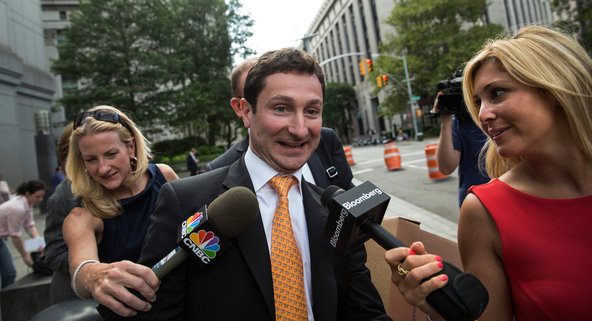 Andrew Burton/Getty ImagesFabrice Tourre, a former Goldman Sachs trader, outside a Manhattan federal court on Monday.
Andrew Burton/Getty ImagesFabrice Tourre, a former Goldman Sachs trader, outside a Manhattan federal court on Monday.
The Securities and Exchange Commission had hoped to use Paolo Pellegrini, a chief architect of one of the most lucrative hedge fund bets in history, to buttress its case against Fabrice Tourre, a former Goldman Sachs trader charged with defrauding investors in a complex mortgage security.
But on Wednesday, Mr. Pellegrini did his best to try and dynamite the government’s case. At one point, he apparently contradicted testimony he had previously given in a deposition with S.E.C. lawyers, leading to a terse exchange on the witness stand.
Mr. Pellegrini’s role in helping Paulson Company earn $1 billion by betting against home loans through an investment assembled in part by Mr. Tourre made him an ideal witness for the government’s side. The S.E.C. had been hoping to use the hedge fund executive to show that the onetime Goldman employee failed to let investors in the mortgage security know that Paulson Company was actually betting against them.
That plan was thrown into disarray during several hours of combative testimony in a Lower Manhattan federal courtroom on Wednesday, as Mr. Pellegrini — who had already proved a difficult presence — repeatedly accused the agency of trying to trick and intimidate him.
Related Links
In perhaps the most striking moment of the trial so far, the witness asserted that he had informed an executive at the bond insurer, the ACA Financial Guaranty Corporation, one of the purported victims of the failed investment, that his then-employer did in fact intend on betting against the mortgage deal.
That led to the first of several battles between Mr. Pellegrini and Matthew Martens, the S.E.C.’s lead lawyer in the case, over what the hedge fund executive had previously testified under oath. Mr. Martens, his voice tight and arms crossed over his chest, repeatedly read back Mr. Pellegrini’s previous claim that he could not recall telling ACA of Paulson Company’s intentions.
Mr. Pellegrini, fixing an unblinking stare at his questioner, instead contended that he used those words “under pressure” from the S.E.C. and its “hostile questions.” He subsequently explained that he intentionally took a more careful and vague approach during the deposition because he was concerned that the agency was trying to deceive him.
“You are tricking me into saying so many things,” Mr. Pellegrini declared on the witness stand at one point. At another, he said, “It depends on what you mean by factual knowledge.”
The change of heart could cut against a core assertion of the S.E.C. that Mr. Tourre had failed to tell ACA and another investor that the mortgage security at the heart of the case was constructed in large part by a hedge fund betting against its success. In a court filing from March, the agency quoted Mr. Pellegrini as saying that he had trouble meeting with potential partners if he made it known that he would bet against them. A number of e-mails presented in court on Wednesday suggested that Mr. Pellegrini’s boss, the hedge fund billionaire John Paulson, and one adviser were aware of the troubles that publicizing the bet against mortgages would pose.
An executive at ACA has testified that executives at Goldman and at Paulson had failed to make the true nature of the hedge fund’s interest known.
But Mr. Pellegrini insisted repeatedly in court that he had informed several potential business partners that Paulson Company intended on betting against securities built on home loans, depicting a firm whose motivations should have been well-known in the investment community. At one point, he suggested that his memory was jogged in part by helpful instruction from the presiding judge in the case, Katherine B. Forrest.
Barely veiled contempt colored many of the exchanges between Mr. Pellegrini and Mr. Martens. When the S.E.C. lawyer asked the witness to find a particular section of a document, Mr. Pellegrini leaned back in his chair, casually sipped from a cup of water, and drily asked, “Do you mind locating it for me?”
During a break in proceedings, Mr. Martens told Judge Forrest that he thought the hedge fund executive’s claims to have been pressured by his office was “garbage.”
Article source: http://dealbook.nytimes.com/2013/07/17/in-tourre-trial-s-e-c-wages-battle-against-its-own-witness/?partner=rss&emc=rss